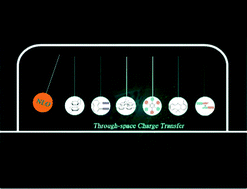The inspiration and challenge for through-space charge transfer architecture: from thermally activated delayed fluorescence to non-linear optical properties
Abstract
Organic molecules consisting of electron donor (D) and electron acceptor (A) subunits linked by π-conjugated bridges are promising building blocks for thermally activated delayed fluorescence (TADF) and non-linear optics (NLO) materials due to their intramolecular charge transfer (CT) processes in response to external stimuli. According to the electron interaction pattern, the CT process in D–π–A architectures can be divided into two categories, through-bond/-space charge transfer (TB/TSCT). To date, research into the TADF properties of TSCT characteristic molecules has since seen significant growth. In fact, TSCT characteristic materials show great advantages in such NLO responses. In this perspective, we first briefly introduced the basic principles of NLO and TADF effects. Successively, we discuss the influence of TBCT and TSCT patterns on NLO and TADF properties, especially for TSCT characteristic. In the final part, we address the diversity and potential advantages of TSCT characteristic molecules as high-performance NLO materials. With these, it is expected that the greater structural flexibility of spatial conjugation can bring more functionality to NLO materials in the future.

- This article is part of the themed collection: PCCP Perspectives


 Please wait while we load your content...
Please wait while we load your content...